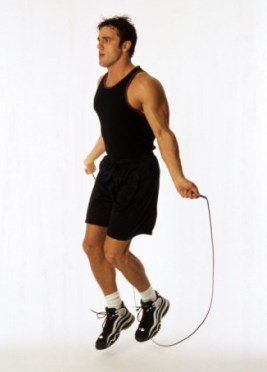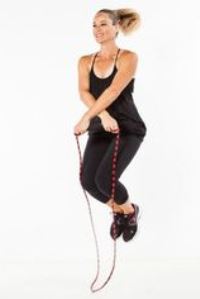Skipping
 Skipping doesn’t require much introduction. We have all played with skipping ropes (also known as jump ropes) back when we were kids; or at the very least, we’ve seen our friends and sibling play with them. Back then, little did we know that skipping is a legit exercise that athletes all around the world have incorporated in their regular workout!
Skipping doesn’t require much introduction. We have all played with skipping ropes (also known as jump ropes) back when we were kids; or at the very least, we’ve seen our friends and sibling play with them. Back then, little did we know that skipping is a legit exercise that athletes all around the world have incorporated in their regular workout!
As we grew up, most people lost their skipping rope or just gave up on skipping. However, this fun childhood game should be brought back as it has lots of health benefits. But before discussing that, let’s learn a few important things about this exercise.
What equipment do I need for skipping?
The best part about skipping is that it only needs one equipment – the rope! Skipping ropes are available pretty much everywhere, and are quite inexpensive. You don’t need to buy the expensive ones, but that is your choice.
However, you need to consider the quality of the rope. It is of utmost importance that the rope is easy to use and can turn inside the handle without any entanglement. If possible, avoid the ropes made with cloths as they can cause entanglements. Ropes with plastic beads are quite easy to use.
Do make sure that the rope you choose is of the right length for you, or at least can be adjusted or cut according to your need. Also consider the quality of the handles – if they keep slipping out of your grip, you probably shouldn’t use them as that will only make your skipping experience complicated.
How do I skip?
In case you haven’t learned skipping as a child, don’t worry. Most people who can’t skip find it intimidating. But once you start, you’ll realize that it is quite easy once you get the gist of it.
Start without the rope. Stand on the balls of your feet in a tip-toe like position, with your knees bent very slightly. Next, jump but not too high. Keep practicing this until you get used to this motion and can do it in a perfect rhythm.
Then, pick up the rope and start practicing. Bring the rope from back to front over your head, jump as it gets close to your feet, and land back on ground after the rope has passed below you and is behind you again. Find a perfect speed for your skipping motion. Don’t fret if you trip in the first several attempts. Time your jumps according to the speed till you can do it comfortably.
One thing to remember is that you should place your elbows around your waist and extend your arms sideways. Only your wrists will move to facilitate the rotation of the rope. However, if you are just starting to learn, don’t force yourself to do it, rather learn to do this gradually.
What are the different styles and techniques?
If you already know how to skip, you can start to learn some advance techniques and styles to incorporate in your exercise. There are many different styles, but let’s take a quick look at the common ones. Do note that these will not be so easy to perform at first, so you need to be careful not to injure yourself.
 Crossover – A crossover is when you do a normal skipping routine, but cross over your arms in front of you right before you jump through the loop that is created.
Crossover – A crossover is when you do a normal skipping routine, but cross over your arms in front of you right before you jump through the loop that is created.
Alternate legs – In this technique, instead of jumping with both legs at the same time, you jump with one leg first, followed by the other – quite like a running motion.
Double jumps – A double jump is an intense and difficult step and can be very challenging. In this case, you jump really high and try to pass the rope under your feet two times before you land back on the ground. It is indeed very challenging, but many athletes use this technique as their regular work-out routine.
There are quite a few other techniques you can consider such as the Double Dutch where you are to jump over two ropes travelling in opposite direction, and the high knees, which is a more rigorous version of the alternate legs technique.
What are the health benefits of skipping?
As mentioned previously, skipping has a lot of health benefits. Let’s discuss those.
Weight Loss
Skipping helps in losing weight. Skipping is an exercise that helps you burn a lot of calories, depending on your weight, food intake and activities. A person of average weight can burn about 700 calories by skipping, but the rate can be higher depending on the intensity of the work out. This in turn can effectively help you in losing your weight.
Cardiovascular Health
Skipping improves your cardiovascular health. Your heartbeat increase when you skip. As a result, your heart and the vessels are worked more, leading to an improved cardiovascular fitness. This in turn leads to better blood circulation around the body, and you also feel less breathless, meaning that you don’t tire quickly. However, if you are very overweight, you should consult your doctor before skipping regularly.
Muscle Tone
Skipping aids in muscle toning. Skipping regularly will help you to tone your leg and thigh muscles, as well as your upper body muscles around the arms and shoulders. This can also lead to a toning of the abs.
Balance & Coordination
Skipping improves balance and coordination in your body. As you need to time your jumps with the hand motions, your balance and coordination gets better. You also gain more agility with practice. That is one reason why athletes often use skipping in their daily exercise.
Skipping has lesser impact on your joints compared to running and jogging. As you don’t jump very high, the impact on your landing on the ground does not cause excessive shocks on your body joints. But if you jump very high while skipping on a regular basis, this can adversely affect your joints.
As we can see, skipping is not only a fun activity, it has a lot of health benefits. So what are you waiting for? Find that skipping rope from the depths of your closet and get started!
